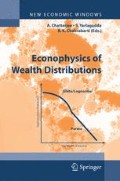Abstract
We develop a stochastic model where the poorer end of the society engage in two-party trading while the richer end perform trade with gross entities. Using our model we are able to capture some of the essential features of wealth distribution in societies: the Boltzmann-Gibbs distribution at the lower end and the Pareto-like power law tails at the richer end. A reasonable scenario to connect the two ends of the wealth spectrum is presented. Also, we show analytically how different power law exponents can be obtained. Furthermore, a link with the models in macroeconomics is also attempted.
Access this chapter
Tax calculation will be finalised at checkout
Purchases are for personal use only
Preview
Unable to display preview. Download preview PDF.
References
Kennickell AB (Sept. 2003) A rolling tide: Changes in the distribution of wealth in the U.S., 1989–2001. Mimeo
Pareto V (1897) Cours d’Economie Politique. Lausanne
Quadrini V, Ríos-Rull J-V (Spring 1997) Understanding the U.S. distribution of wealth. Federal Reserve Bank of Minneapolis Quarterly Review 21(2): 22–36
Aiyagari S Rao (Aug. 1994) Uninsured idiosyncratic risk and aggregate saving. Quarterly Journal of Economics 109(3): 659–684
Dragulescu AA (2003) Applications of physics to economics and finance: money, income, wealth, and the stock market. cond-mat/0307341
Willis G, Mimkes J (2004) Evidence for the independence of waged and unwaged income, evidence for Boltzmann distributions in waged income, and the outlines of a coherent theory of income distribution. cond-mat/0406694
Chakraborti A, Chakrabarti BK (2000) Statistical mechanics of money: how saving propensity affects its distribution. European Physical Journal B 17:167–170
Das A, Yarlagadda S (2003) Analytic treatment of a trading model. Physica Scripta T 106:39–40
Dragulescu AA, Yakovenko VM (2000) Statistical mechanics of money. European Physical Journal B 17:723–729
Chatterjee A, Chakrabarti BK, Manna SS (2003) Money in gas-like markets: Gibbs and Pareto laws. Physica Scripta T 106:36–38
Slanina F (2004) Inelastically scattering particles and wealth distribution in an open economy. Physical Review E 69:046102(1)–046102(7)
Solomon S, Richmond P (2001) Power laws of wealth, market order volumes and market returns. Physica A 299:188–197
Sinha S (2005) The rich are different: Pareto-like power law distributions from wealth dependent asymmetric interactions in asset exchange models. This volume
Ferrero JC (2005) The monomodal and bimodal statistical distribution of money. This volume
Bouchaud J-P, Mézard M (2000) Wealth condensation in a simple model of economy. Physica A 282:536–545
Scafetta N, Picozzi S, West BJ (2004) An out-of-equilibrium model of the distributions of wealth. cond-mat/0403045
Pianegonda S, Iglesias JR (2003) Inequalities of wealth distribution in a conservative economy. cond-mat/0311113
Souma W (2002) Physics of personal income. cond-mat/0202388
A more detailed account of our model is presented in Das A, Yarlagadda S (2004) An analytic treatment of the Gibbs-Pareto behavior in wealth distribution. cond-mat/0409329 (accepted in Physica A)
Silva AC, Yakovenko VM (2005) Temporal evolution of the “thermal” and “superthermal” income classes in the USA during 1983–2001. Europhysics Letters 69:304–310
Favero CA (2001) Applied macroeconometrics. Oxford university press, New York
Author information
Authors and Affiliations
Editor information
Editors and Affiliations
Rights and permissions
Copyright information
© 2005 Springer-Verlag Italia
About this chapter
Cite this chapter
Yarlagadda, S., Das, A. (2005). A Stochastic Trading Model of Wealth Distribution. In: Chatterjee, A., Yarlagadda, S., Chakrabarti, B.K. (eds) Econophysics of Wealth Distributions. New Economic Windows. Springer, Milano. https://doi.org/10.1007/88-470-0389-X_14
Download citation
DOI: https://doi.org/10.1007/88-470-0389-X_14
Publisher Name: Springer, Milano
Print ISBN: 978-88-470-0329-3
Online ISBN: 978-88-470-0389-7
eBook Packages: Business and EconomicsEconomics and Finance (R0)

